Profile of the United States Army: Army Service Component Commands
Profile of the United States Army: Army Service Component Commands
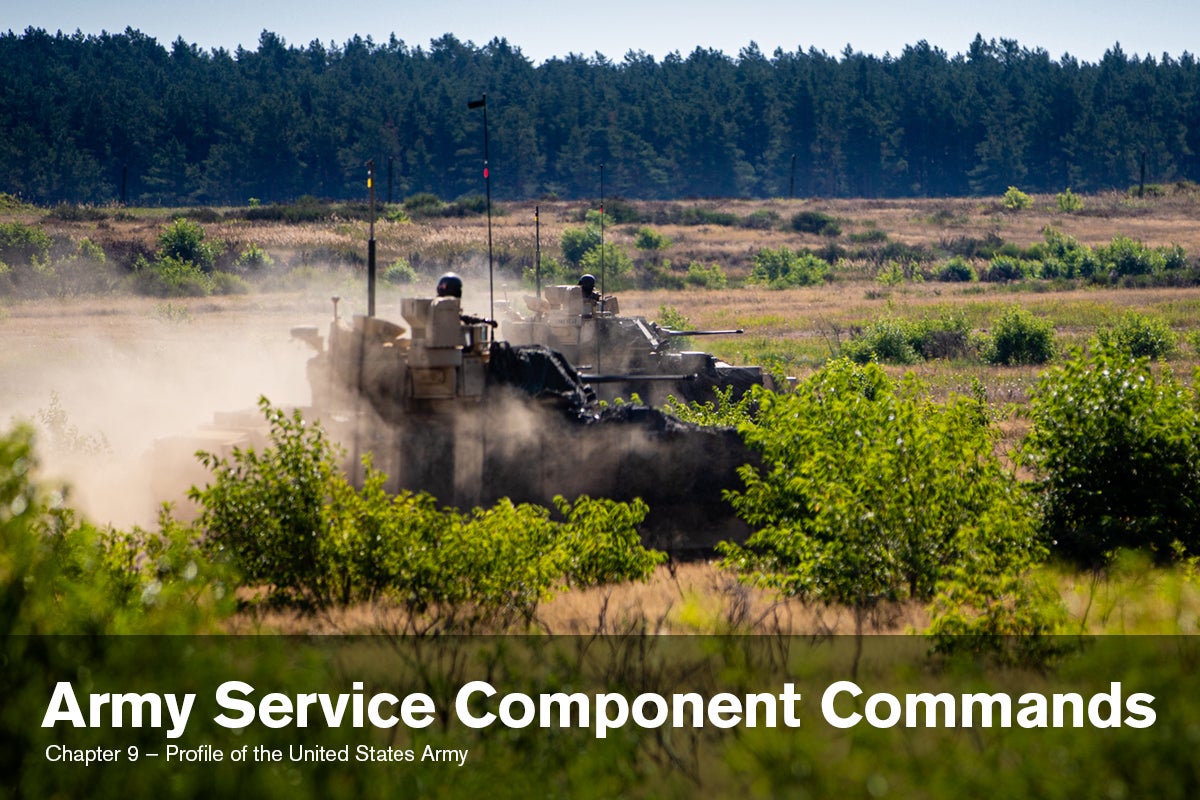
This is Chapter 9 of the 2022 Profile of the United States Army, a top-to-bottom reference handbook that lays out everything you need to know about how and why the Army works—and what it’s doing around the world right now. Links to other chapters can be found at the bottom of this page.
Army Service Command Components (ASCCs) are the Army piece of combatant commands in the joint force. They are responsible for recommendations to the joint force commander on the allocation and employment of U.S. Army forces within a combatant command. Additionally, some are further assigned as Major Subordinate Commands (MSCs) to one of the four Army Commands discussed in Chapter 8. There are 9 ASCCs:
- U.S. Army Central (USARCENT), the ASCC of U.S. Central Command (USCENTCOM);
- U.S. Army Cyber (ARCYBER), the ASCC of U.S. Cyber Command (USCYBERCOM);
- U.S. Army Europe-Africa (USAREUR-AF), the ASCC of U.S. European Command (USEUCOM);
- Military Surface Deployment and Distribution Command (SDDC), the ASCC of U.S. Transportation Command (USTRANSCOM) and MSC to U.S. Army Materiel Command (AMC);
- U.S. Army North (USARNORTH), the ASCC of U.S. North Command (USNORTHCOM);
- U.S. Army Pacific (USARPAC), the ASCC of U.S. Indo–Pacific Command (USINDOPACOM);
- U.S. Army South (USARSOUTH), the ASCC of U.S. Southern Command (USSOUTHCOM);
- U.S. Army Space and Missile Defense Command (SMDC), the ASCC of U.S. Strategic Command (USSTRATCOM); and
- U.S. Army Special Operations Command (USASOC), the ASCC of U.S. Special Operations Command (USSOCOM).

U.S. Army Central
(USARCENT)
Shaw Air Force Base, South Carolina
Mission: USARCENT is the ASCC of U.S. Central Command (CENTCOM) and is responsible to the secretary of the Army for the support and administration of more than 12,000 Soldiers, including those assigned to joint task forces and embassies, across the 21 countries in the CENTCOM area of responsibility (AoR).
The CENTCOM commander has designated USARCENT as the coalition forces and land component command (CFLCC) for planning, preparation and for ensuring uninterrupted logistics support to ongoing operations. Portions of USARCENT’s combat forces are designated as a rapid reaction force able to respond to emergencies anywhere in the AoR. USARCENT remains on call to command units in direct combat, as happened in Kuwait in 1990, in Afghanistan in 2001 and in Iraq in both 2003 and 2014.
Activities: A baseline of forces in the CENTCOM AoR is required to ensure that USARCENT maintains key access, basing and overflight permissions to reassure partners and protect U.S. interests. Through strong partnerships and forward presence, USARCENT maintains CENTCOM’s ability to support integrated deterrence, retain freedom of action, and rapidly deploy combat-ready forces anywhere in the AoR in the event of a contingency. USARCENT effectively shapes and sets the theater, supports current operations and strengthens partnerships and interoperability to advance and safeguard U.S. interests, compete against China and Russia, deter aggression and regional malign influence, including Iran, its surrogates and violent extremist organizations.
The geostrategic location of the CENTCOM AoR is important due to its foundational source of global energy and its being a thoroughfare for international commerce. More than 27 percent of global oil travels through the Strait of Hormuz and over 20 percent of global commerce depends on the Suez Canal. Disruptions of oil shipments in the region are felt both at home and abroad; for example, when a single ship was stuck in the Suez Canal in March 2021, it cost $400 million per hour in commerce.
The CENTCOM AoR provides key terrain and a dominant position for the U.S. to strategically compete with China and Russia through a range of security cooperation ventures including border security, counter narcotics, counter terrorism and defense institution building—activities that allow USARCENT to maintain status as partner of choice in the region. Strategic competitors recognize the importance of relationships in the region, seeking to draw partners and allies away from the United States. USARCENT maintains a competitive advantage against adversaries by implementing a long-term, committed approach that not only deepens interoperability but also innovates with partners.
One area where USARCENT will continue to innovate with regional partners is in countering the threat of unmanned aerial systems (UAS). The UAS threat is a shared security challenge for the United States and its regional partners. Due to its low cost to entry, it is becoming the weapon of choice for adversaries, resulting in rapid technology proliferation and increased employment against U.S. forces and partners. To combat this threat, USARCENT will test and field counter-UAS systems and will implement best practices by working closely with partners. The aim is to develop a counter-UAS threat solution that combines the efforts of interagency, law enforcement and regional partners and allies.
The 3rd Security Force Assistance Brigade (SFAB) in the CENTCOM theater also offers a purpose-built and scalable method for persistent engagement with partners that builds the military capacity required for defending against common threats. The SFAB has a presence in Iraq, Kuwait, Jordan and the United Arab Emirates, with plans for persistent presence in the Kingdom of Saudi Arabia. They will execute subject matter exchanges and exercises across Egypt, Bahrain, Oman, Qatar, Uzbekistan, Lebanon and Tajikistan. Complex and interconnected challenges cannot be faced alone; they require improving partners’ collective defensive capabilities by building and maintaining multilateral constructs that the SFAB directly sustains.
USARCENT deepens military partnerships by conducting approximately 20 military exercises with partners each year. It also conducts more than 200 theater security cooperation events, including symposiums, conferences and exchanges, with 17 nations each year. Mutually beneficial partnerships and alliance architectures are USARCENT’s greatest strategic advantage. Its theater security partnership program is daily evidence that the United States remains a reliable and committed regional partner. To further the goal of maintaining partner-of-choice status, USARCENT supports initiatives that optimize the speed and effectiveness of foreign military sales and foreign military financing, including the increased use of international military education and training. Efforts to improve these initiatives will strengthen U.S. credibility in the region and result in stronger military partnerships.
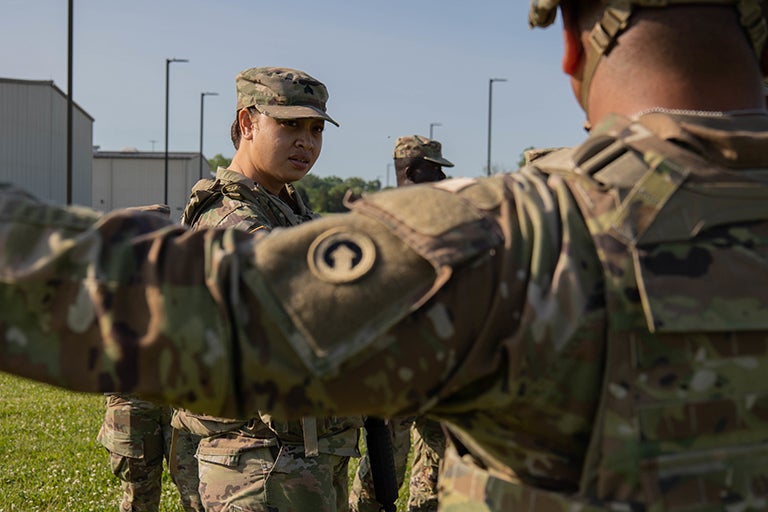 Sergeant Tuu Valaau, human resources specialist, 1st Theater Sustainment Command, acts as a platoon sergeant during patrol base checkpoint training on Fort Knox, Kentucky, 12 May 2022 (U.S. Army photo by Specialist Cecilia Soriano).
Sergeant Tuu Valaau, human resources specialist, 1st Theater Sustainment Command, acts as a platoon sergeant during patrol base checkpoint training on Fort Knox, Kentucky, 12 May 2022 (U.S. Army photo by Specialist Cecilia Soriano).
The USARCENT headquarters consists of approximately 1,000 Soldiers and civilians primarily at Shaw Air Force Base in South Carolina. Permanently assigned and allocated units are as follows:
- Task Force Spartan provides command and control of combat forces in theater, strengthens defense partnerships and provides crisis response forces. The critical headquarters organization is manned by National Guard Division Headquarters on nine-month rotations.
- 1st Theater Sustainment Command ensures that land forces have food, water, fuel, ammunition, building materials, equipment and repair parts, along with maintenance and human resourcing support. The command also manages air and seaports, flights and customs points and provides transportation services throughout the theater, including integration of joint forces.
- 32nd Army Air and Missile Defense Command performs critical theater air and missile defense planning and execution functions. It coordinates and integrates theater missile defense activities to protect contingency, forward deployed and reinforcing forces, as well as designated theater strategic assets.
- 3rd Medical Command provides surgical, dental, behavioral health and veterinary support, including a Level III trauma center at Camp Arifjan, Kuwait.
- 4th Battlefield Coordination Detachment is the Army liaison to the air component commander.
- 335th Signal Command provides communications and cyber support.
- 513th Military Intelligence Brigade provides all-source intelligence and security support.
- 3rd Security Force Assistance Brigade provides persistent partnership.
- Area Support Groups in Kuwait and Jordan provide base operations and training support for rotational forces.
USARCENT also commands multiple units on nine-month tours, including infantry, armor, fires, air defense, engineers, military police and sustainers. Soldiers assigned to USARCENT headquarters follow Third Army’s lineage and honors, proudly wearing the Circle A shoulder patch made famous in World War II by General George S. Patton.
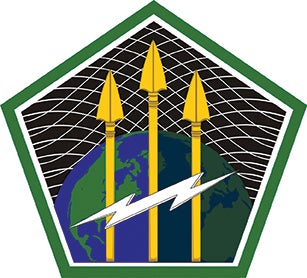
U.S. Army Cyber Command
(ARCYBER)
Fort Gordon, Georgia
Mission: ARCYBER integrates and conducts cyberspace operations, electromagnetic warfare and information operations, ensuring decision dominance and freedom of action for friendly forces in and through the cyber domain and the information dimension, while denying the same to adversaries. As part of the joint Cyber Mission Force under U.S. Cyber Command, ARCYBER defends DoD networks, systems and data; provides designated combatant commanders with defensive and offensive cyber capabilities; and defends U.S. critical infrastructure as part of a whole-of-nation effort.
Operating, protecting and defending the Army network is ARCYBER’s most critical mission. The Army network consists of more than 1 million endpoints, part of a global network underpinning all Army operations. It is also a weapon system for cyberspace operations, providing Army commanders with options across the information dimension.
Activities: ARCYBER forces are currently spread across four states and five regional cyber centers and are deployed in locations around the globe. Its primary elements include the ARCYBER Headquarters, the Army Cyber Protection Brigade, the 915th Cyber Warfare Battalion and the Joint Force Headquarters–Cyber (Army) at Fort Gordon, Georgia; the 1st Information Operations Command at Fort Belvoir, Virginia; the 780th Military Intelligence Brigade at Fort Meade, Maryland; and the Network Enterprise Technology Command at Fort Huachuca, Arizona.
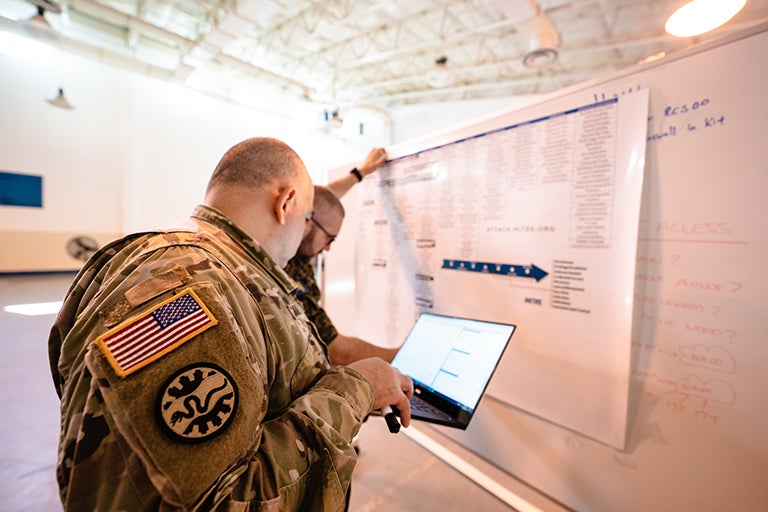 A member of the 169th Cyber Protection Team (CPT) and members of the Armed Forces of Bosnia and Herzegovina conduct cyber adversarial exercises at the Private Henry Costin Readiness Center in Laurel, Maryland, on 29 June 2022 (U.S. Army National Guard photo by Sergeant Tom Lamb).
A member of the 169th Cyber Protection Team (CPT) and members of the Armed Forces of Bosnia and Herzegovina conduct cyber adversarial exercises at the Private Henry Costin Readiness Center in Laurel, Maryland, on 29 June 2022 (U.S. Army National Guard photo by Sergeant Tom Lamb).
ARCYBER’s approximately 16,500 Soldiers, civilian employees and contractors execute a complex global mission, 24/7, guided by five lines of effort:
- Attract, Develop and Sustain a World-Class Workforce. To meet its demand for cyber talent, ARCYBER has adapted innovative strategies, including a direct commissioning program, for specific technical talent. The command also has a federal civilian career program for cyberspace effects; a new area of concentration (tool developer) for officers and warrant officers within the cyber branch; and internship and fellowship programs to develop and mentor the best young minds in the cyber community. Additionally, the Army has integrated functional area 30 (FA30) of electronic warfare (EW) into the cyberspace operations branch (17B). The command has also partnered with the defense digital service, bringing some of its technically gifted Soldiers together with interns and private sector civilian talent—an incubator environment that rapidly develops immediate-need, Army-unique cyber capabilities.
- Aggressively Operate and Defend Networks, Data and Weapon Systems. This effort is a foundational capability for the joint force and the Army. The Army network is a weapon system vital to all operations; operating, defending and modernizing the Army portion of the DoD Information Network (DoDIN); improving readiness and defenses; achieving greater standardization and interoperability; and disposing of older, less secure systems. These efforts are allowing for increased bandwidth, for a move toward a cloud-based and virtualized architecture and for a consolidation of data centers to enhance security.
- Deliver Effects against Adversaries. ARCYBER’s forces are globally deployed and actively engaged in DoDIN operations as well as in offensive and defensive cyberspace operations that support joint and Army commanders. The command also continues its tactical Cyber and Electromagnetic Activities (CEMA) support to corps and below initiative, providing expeditionary CEMA teams to brigade combat teams during their rotations at combat training centers (CTCs). Based on the lessons learned at the CTCs, the Army approved new force structure, providing scalable, expeditionary CEMA forces at the brigade, division and corps level, and it established the first prototype unit with cyber, signal, EW and Information Operations together in one unit: the 915th Cyber Warfare Battalion at Fort Gordon, Georgia, in May 2019. Projected to be at full strength by 2024, the 915th’s expeditionary CEMA teams support Army-centric missions, conducting operations against targets for deny, degrade, disrupt, destroy and manipulate effects, with the intent to fully integrate non-kinetic and kinetic operations, a key enabler of Multi-Domain Operations (MDO).
- Strengthen and Expand Partnerships. Cyberspace operations are inherently joint and multi-domain; ARCYBER relies on its signal corps and intelligence mission partners across the Army, joint and interagency communities to provide support and expertise that offers commanders critical capabilities in the information dimension. The Army Cyber Mission Force is a participant in the Total Force and partners with the reserve components to bring unique experiences and expertise to the force. Partnerships with industry, academia and the research community are also key to implementing cutting-edge technologies and best practices to stay ahead of cyber threats. ARCYBER is continually evolving to meet the changing needs of the Army and the joint force in the information age and will continue to seek new and innovative partnerships to stay ahead of adversaries and to ensure that the Army remains a decisive force across all domains.
- Increase Lethality and Improve Readiness. Increasing the Army’s overall lethality depends upon providing warfighters with reliable and secure mission command communications to support MDO and to ensure decision dominance. As part of that effort, ARCYBER continually explores new approaches for delivering enterprise-level network and core information technology services.
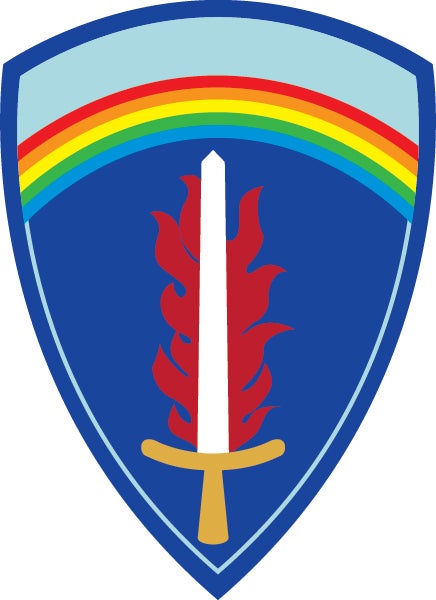
U.S. Army Europe-Africa
(USAREUR-AF)
Wiesbaden, Germany
Mission: USAREUR-AF is a four-star Army headquarters that consists of approximately 64,000 U.S. Army personnel assigned and deployed across an area of responsibility (AoR) encompassing 104 nations on the European and African continents. USAREUR-AF is strategically positioned to deter aggression and to assure allies and partners of the U.S. commitment to peace and stability in Europe and Africa. It provides ready, combat-credible land forces to deter, and, if necessary, defeat aggression from any potential adversary across the AoR. To achieve this, it sets the essential conditions necessary and is prepared to serve as a combined joint force land component command, to fight and win across the full spectrum of military operations from contingency response to large-scale, ground combat operations.
To respond to crises, the right forces must get to the right place at the right time. USAREUR-AF sets the theater to ensure the agile flow of forces into and throughout both the African and European theaters when called upon.
The United States stands by its allies and partners as they have stood by her. Because allies and partners are key to the U.S. Army’s overall strength, USAREUR-AF builds and sustains strong relationships and promotes multinational military interoperability and capacity building.
Activities: Only well-postured, modernized and interoperable strategic landpower can deter competitors and defeat adversaries. USAREUR-AF’s forward presence provides the U.S. military with the strategic access vital to missions and operations in both theaters. With a balanced mix of both permanent and rotational forces, USAREUR-AF is a flexible, agile and well-postured organization that deters potential threats, reassures allies and is uniquely positioned to respond and win, should deterrence fail. Subordinate commands, V Corps and Southern European Task Force, Africa (SETAF-AF) enable USAREUR-AF’s ability to oversee Army operations across two continents.
 U.S. Army Soldiers from Task Force Pegasus conduct an air assault operation with multi-national partners from the Republic of Latvia and the Republic of Poland in Kosovo on 30 June 2022 (U.S. Army National Guard photo by Sergeant Alexander Hellmann).
U.S. Army Soldiers from Task Force Pegasus conduct an air assault operation with multi-national partners from the Republic of Latvia and the Republic of Poland in Kosovo on 30 June 2022 (U.S. Army National Guard photo by Sergeant Alexander Hellmann).
Headquartered at Fort Knox, Kentucky, with a permanent forward command post in Poznan, Poland, V Corps provides oversight of operations in Europe and serves as a key integrating headquarters to improve interoperability with allies and partners. V Corps commands and controls both Atlantic Resolve rotational units as well as assigned units that include 2nd Cavalry Regiment, 12th Combat Aviation Brigade and the 41st Field Artillery Brigade.
Similarly, SETAF-AF, headquartered in Vicenza, Italy, serves as the nucleus of a joint task force for operations on the African continent. SETAF-AF focuses on building partner capacity, security cooperation activities and crises responses. It is responsible for all Army operations and assets in Africa and Italy, to include the 173rd Airborne Brigade and Security Force Assistance Brigade teams deployed to Africa.
Operational and theater enablers such as the 56th Artillery Command, 2nd Multi-Domain Task Force, 21st Theater Sustainment Command, 10th Army Air and Missile Defense Command, 7th Army Training Command, 79th Theater Sustainment Command, 66th and 207th Military Intelligence Brigades, 2nd Theater Signal Brigade, U.S. Army NATO Brigade, Installation Management Command-Europe and Regional Health Command-Europe provide essential skills and services that support the entire force.
The USAREUR-AF tiered exercise program builds readiness, enhances interoperability and strengthens relationships by providing a joint, multinational environment to prepare allies and partners to train as they fight. Training together now builds relationships and provides shared understanding when conflict occurs. It enhances combined capabilities through the continued emphasis on interoperability, modernization and building partner capacity. Interoperability is not just about systems and technology; it is about people, processes and relationships that build stronger teams, foster overmatch and increase lethality.
USAREUR-AF is responsible for supporting the NATO Enhanced Forward Presence effort with forces in Poland and for maintaining a constant presence in the NATO-led Kosovo Force mission. It also supported and maintained oversight of the Georgia Defense Readiness Program-Training and Joint Multinational Training Group-Ukraine training missions while they were active. Additionally, it participates in security cooperation events on both continents each year. Supported by Security Force Assistance Brigades and National Guard state partners, these enhance professional relationships and improve overall interoperability with allies and partners.
U.S., European and African defense concerns are inseparable as part of a stable international order. Together, these continents face a growing number of transnational threats, to include armed conflict, violent extremism, global terrorism, illicit trafficking, the proliferation of weapons of mass destruction and infectious disease. Close geographic and economic ties between Europe and Africa mean that a regional security issue left unchecked could quickly spread between both continents. Consequently, USAREUR-AF will remain at the center of the framework both for a strong deterrence and a solid defense posture on both continents. Its continued presence strengthens the security and stability in the region, provides the physical deterrence necessary to counter threats to U.S. interests and honors international and NATO commitments.
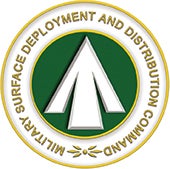
Military Surface Deployment and Distribution Command
(SDDC)
Scott Air Force Base, Illinois
Mission: SDDC provides integrated and synchronized global deployment and distribution capabilities to the point of need.
Activities: As both the ASCC to U.S. Transportation Command and an MSC to U.S. Army Materiel Command (AMC), SDDC connects and synchronizes surface warfighting requirements through distribution network nodes to the point of need, responsively projecting power and delivering desired effects in support of combatant commands and the joint force. The command also partners with the commercial transportation industry as the coordinating link between DoD surface transportation requirements and the capability that industry provides. With nine total force brigades geographically located throughout the world to support combatant commanders, SDDC is globally postured to deliver readiness to the joint warfighter.
Maintaining a workforce of approximately 5,200 trusted professionals, SDDC is the premier total force deployment and distribution synchronizer, always ready, with capabilities available to project and sustain the nation’s combat power even in the most austere conditions. Its Transportation Engineering Agency provides DoD with engineering, policy guidance, research and analytical expertise, ensuring that U.S. military forces can respond successfully to any requirement anywhere in the world. Meanwhile, the U.S. Army Reserve Deployment Support Command (DSC) provides SDDC with an integrated total force capability. Operationally controlled by SDDC and headquartered in Birmingham, Alabama, the DSC provides four reserve transportation brigades and an expeditionary rail center to support SDDC operations.
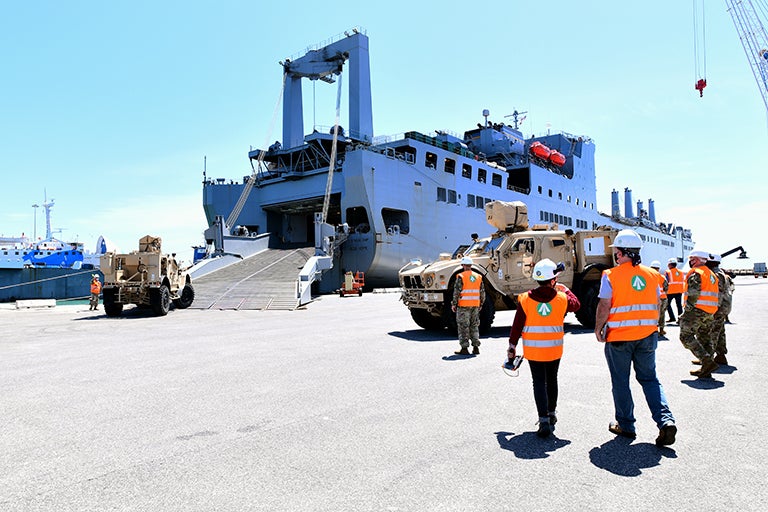 The 839th Transportation Battalion, 598th Transportation Brigade, Surface Deployment and Distribution Command loads more than 200 U.S. Army vehicles onto the USNS Bob Hope at the Livorno, Italy, port facility. These vehicles will transit to the U.S. for further distribution to units throughout the Army (U.S. Army photo by Elena Baladelli).
The 839th Transportation Battalion, 598th Transportation Brigade, Surface Deployment and Distribution Command loads more than 200 U.S. Army vehicles onto the USNS Bob Hope at the Livorno, Italy, port facility. These vehicles will transit to the U.S. for further distribution to units throughout the Army (U.S. Army photo by Elena Baladelli).
SDDC has five subordinate active component transportation brigades headquartered around the world, each with its own activities and responsibilities:
The 595th Transportation Brigade, at Camp Arifjan, Kuwait, through a cohesive team of experts, links strategic warfighter surface movement requirements with the appropriate commercial capability. To this end, it works through a combination of organic, commercial and host-nation capabilities, offering maximum options and solutions to supported forces while promptly delivering equipment and sustainment in support of U.S. Central Command.
The 596th Transportation Brigade, at Military Ocean Terminal Sunny Point (MOTSU), North Carolina, safely provides ammunition terminal services to meet the nation’s objectives. This responsibility includes the operation of both East and West Coast terminals at MOTSU and Military Ocean Terminal Concord, California, respectively, and the western half of the U.S. Northern Command (USNORTHCOM) area of responsibility (AoR).
The 597th Transportation Brigade, at Joint Base Langley–Eustis, Virginia, is focused on the eastern half of the USNORTHCOM and the U.S. Southern Command AoRs. Together with its subordinate units, it is responsible for meeting the surface deployment, redeployment and distribution needs of the warfighter and Defense Transportation System customers in the United States.
The 598th Transportation Brigade, at Sembach, Germany, enables full-spectrum operations by performing movement of forces and materiel in support of U.S. European Command (USEUCOM), U.S. Africa Command (USAFRICOM) and U.S. Central Command. The unit has made its mark in dozens of countries, distinguishing itself in every mission and aptly fulfilling its motto, “Warrior Logistics—In Motion.” The brigade sustains forces and provides expeditionary and deliberate port and surface distribution operations in the USEUCOM and USAFRICOM AoRs. Additionally, the unit is prepared to deploy globally on short notice to conduct port and distribution operations.
The 599th Transportation Brigade, at Wheeler Army Airfield, Hawaii, is located with all U.S. Indo-Pacific Command service component commands on the island of Oahu, making the location ideal for brigade members to plan and coordinate effectively with leading supported units. The unit’s location also allows easy access to the Navy port at Pearl Harbor, to Barbers Point Harbor and to Honolulu’s commercial ports. The AoR for the 599th is geographically the largest in the world, covering 52 percent of the earth’s surface, equal to about 105 million square miles.
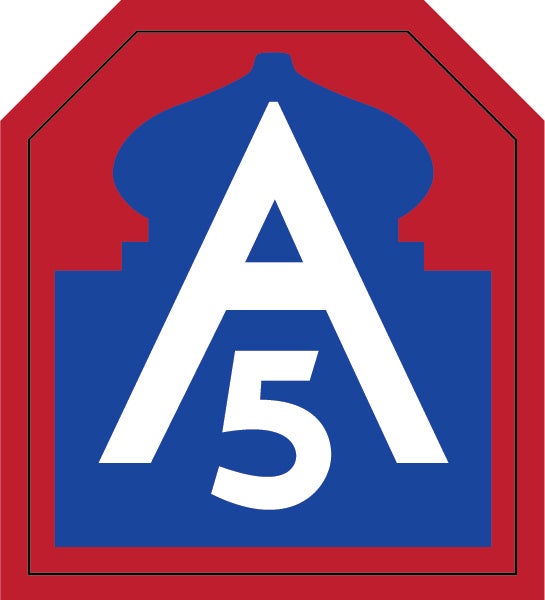
U.S. Army North
(USARNORTH)
Joint Base San Antonio, Fort Sam Houston, Texas
Mission: USARNORTH conducts Multi-Domain Operations in support of U.S. Northern Command (USNORTHCOM) in order to detect, deter and defeat threats to the homeland, conduct defense support of civil authorities (DSCA) and provide security cooperation initiatives to defend the United States and its interests. With its area of responsibility (AoR) covering the continental United States (CONUS), Mexico, Canada, the Bahamas, the Virgin Islands, Puerto Rico and the Arctic, USARNORTH’s range of operations includes three main mission sets: homeland defense, theater security cooperation and DSCA. Given the scope of operations and the complex nature of the operational environment, unity of effort with state, tribal, federal and international partners is critical to mission success.
Activities: After becoming fully operational on 16 October 2006 as the standing joint force land component command to USNORTHCOM, USARNORTH serves as the combatant commander’s primary headquarters for land domain operations. In fulfillment of its three main mission sets, it undertakes the following activities.
Homeland Defense. As the Army’s three-star headquarters dedicated to federal military operations within North America, USARNORTH’s top priority is homeland defense. Within USNORTHCOM’s AoR, the command is responsible for setting the homeland in preparation for defensive operations and setting force protection conditions of all Army entities; it works with Headquarters, Department of the Army, the Army Commands, ASCCs and Direct Reporting Units to ensure the protection of Army infrastructure. USARNORTH supports Operation Noble Eagle by providing administrative control for the Air and Missile Defense Task Force, ensuring their readiness to provide integrated air defense to defend the national capital region. Additionally, USARNORTH is prepared to assume operational control of allocated ground forces to respond anywhere within CONUS to protect and/or secure DoD equities, such as the ability to man, equip and train forces within the homeland and the ability to actively project combat power around the globe.
Security Cooperation. As a Theater Army, USARNORTH conducts security cooperation activities with Mexico and Canada to build defense relationships and to enhance capabilities for self-defense and multinational operations. Theater security cooperation strengthens critical military-to-military partnerships while simultaneously defending the homeland through enhanced regional security. With Mexican partners, USARNORTH conducts military training and side-by-side exercises to build military capacity, enhance interoperability and increase security along the U.S. southern border and approaches. With Canadian allies, USARNORTH activities focus on improved interoperability to ensure the expeditionary capability of Canadian and U.S. forces to deploy and operate together throughout the world.
DSCA. In support of USNORTHCOM, USARNORTH also coordinates and synchronizes with our interagency partners to provide military support to civil authorities. This includes any request for DoD assistance by another federal agency—a full spectrum of operations—from supporting national special security events, such as the United Nations General Assembly and national political conventions, to responding to natural or man-made disasters or CBRN (chemical, biological, radiological or nuclear) incidents. There are about 18,000 personnel with unique CBRN response capabilities at state, regional and federal levels. The primary conduits for federal agencies to request this assistance are USARNORTH’s 10 defense coordinating elements that are geographically aligned with the 10 Federal Emergency Management Agency (FEMA) regions and 54 states, territories or commonwealths. These elements, each led by a defense coordinating officer, serve as the primary liaison with FEMA and other federal, tribal, state and local agencies for coordination of military resources for the full spectrum of DSCA operations. To further aid this coordination, USARNORTH also manages the Army’s emergency preparedness liaison officer program which, when activated, employs senior reserve component officers and noncommissioned officers to assist defense element coordination with state and National Guard authorities and response efforts, to advise civil authorities on Army capabilities and to facilitate coordination between civilian consequence managers and DoD.
Whether it be enhancing the overall security of North America or responding to a man-made or natural disaster, USARNORTH, as the Army’s senior headquarters dedicated to military operations within the homeland, remains vigilant and ready to respond when and as directed.

U.S. Army Pacific
(USARPAC)
Fort Shafter, Hawaii
Mission: USARPAC, the ASCC for USINDOPACOM, provides the joint force with decisive, integrated landpower to consolidate gains across an active campaign to deter in competition, transition and respond to natural and manmade crises and to prevail in conflict in the most consequential region for America’s future. USARPAC is the backbone of integrated deterrence—the sum of capability, posture, signaling and will—in the Indo-Pacific, by delivering unique foundational capabilities to the joint force that only the U.S. Army provides, including integrated air and missile defense; medical; military police; signals; civil affairs; contracting; logistics; and engineering.
With more than 100,000 Soldiers and civilians, USARPAC is the nation’s largest Theater Army. It generates and employs campaign-quality landpower from the Total Army—from its headquarters at Fort Shafter, Hawaii, and in locations across Alaska, Guam, American Samoa, Saipan, Japan and the Republic of Korea—across the theater’s 9,000 miles, spanning the western coast of the continental United States to India. Through the application of campaign-quality landpower, USARPAC defends the homeland, protects our people, safeguards our values and underwrites American commitment to a “Free and Open Indo-Pacific.”
USINDOPACOM designated the USARPAC commander as the theater joint force land component commander, responsible for synchronizing and integrating joint landpower across USARPAC, Marine Corps Forces–Pacific and Special Operations Command–Pacific. USARPAC certified as a combined joint task force during Exercise Pacific Sentry in 2021.
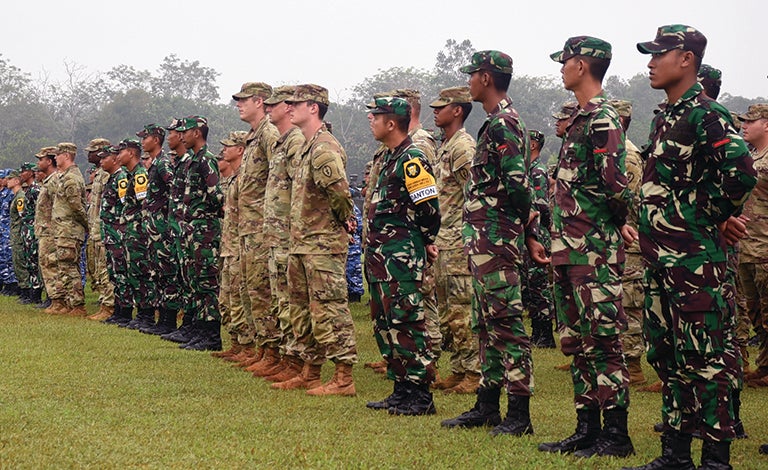 Participants of their respective nations’ armies stand ready for the opening ceremony as part of Super Garuda Shield 2022 in Baturaja, Indonesia, 3 August 2022. Super Garuda Shield—part of Operation PATHWAYS and a longstanding annual, bilateral military exercise conducted between the U.S. and Indonesian militaries—has expanded to a multinational exercise encompassing 14 nations (U.S. Army photo by Specialist Andrew Mendoza).
Participants of their respective nations’ armies stand ready for the opening ceremony as part of Super Garuda Shield 2022 in Baturaja, Indonesia, 3 August 2022. Super Garuda Shield—part of Operation PATHWAYS and a longstanding annual, bilateral military exercise conducted between the U.S. and Indonesian militaries—has expanded to a multinational exercise encompassing 14 nations (U.S. Army photo by Specialist Andrew Mendoza).
Activities: USARPAC nests with the U.S. Indo-Pacific Strategy and USINDOPACOM guidance to “seize the initiative” and “think, act and operate differently” by developing and implementing new approaches, presenting adversaries with new dilemmas and creating new opportunities with joint, interagency and international partners. USARPAC achieves this through two signature efforts: the Joint Pacific Multinational Readiness Center (JPMRC) and Operation PATHWAYS.
JPMRC is the Army’s regional training center in the Indo-Pacific and the Army’s contribution to a top USINDOPACOM priority: the Pacific Multinational Training and Experimentation Capability. JPMRC enables the Army, joint force, allies and partners to train in the environment and conditions where they are most likely to operate: from archipelagos, jungles and heat in the tropics to high altitude and extreme cold in the Arctic. JPMRC further ensures that USARPAC forces remain aggregated and available to the joint force commander, enhancing deterrence and generating readiness that is then projected west of the international dateline (IDL) through Operation PATHWAYS.
JPMRC consists of three parts: JPMRC-Hawaii, JPMRC-Alaska and JPMRC-X, an exportable capability that builds partner training capacity. JPMRC-X deployed for the first time to Garuda Shield 2021 in Indonesia, contributing to Garuda Shield’s subsequent expansion from a historically bilateral, army-to-army exercise to a joint, multinational exercise, including 13 nations and all service components in 2022.
Operation PATHWAYS is USARPAC’s operational design that enables joint force endurance and campaigning by projecting forces west of the IDL. PATHWAYS’ series of tactical actions—exercises, experiments and theater security cooperation programs—solve operational and strategic problems by strengthening defense relationships, increasing multinational interoperability and developing partner military capability and capacity. These regional militaries form the landpower network that binds together the region’s security architecture. Operation PATHWAYS further denies key terrain to potential adversaries and increases joint readiness.
PATHWAYS postures USARPAC to respond to USINDOPACOM requirements in crisis and contingency. In Balikatan, USARPAC contributed to early COVID-19 response and support for the government of the Philippines with 6,000 servicemembers—a direct result of USARPAC efforts to build theater sustainment capability by increasing use of Army watercraft and Army prepositioned stocks. Today, the 5th Security Force Assistance Brigade is also partnering across Asia and Oceania to build resilience and partner capability.
Through PATHWAYS, USARPAC is accelerating experimentation and integration of multi-domain capabilities, bringing new formations into the region to experiment, learn and shape the Joint Warfighting Concept and Army Multi-Domain Operations in real-world conditions. The Army’s 1st Multi-Domain Task Force integrated into regional joint task force multinational and bilateral exercises to test, validate and expand the joint force’s ability to counter an antiaccess/area denial threat when required. The theater fires element further increases Army joint targeting integration by linking sensors and shooters. I Corps experimented with distributed command and control, and the Theater Army continued work to establish a persistent mission-partnered environment in the USINDOPACOM area of responsibility (AoR). During Fiscal Year 2022, USARPAC Soldiers participated in nearly 40 large-scale exercises with over a dozen countries, including all treaty allies in the USINDOPACOM AoR.
Other notable USARPAC events in 2022 included the activation of 11th Airborne Division in Alaska; execution of Land Forces of the Pacific Symposium 2022—the first after a three-year pause due to COVID-19—attended by more than 2,800 people; and execution of the UNIFIED PACIFIC Wargame Series, USARPAC’s contribution to the Joint Campaign of Learning in the Indo-Pacific, advancing enterprise-level understanding of USARPAC’s theater strategic and operational gaps.
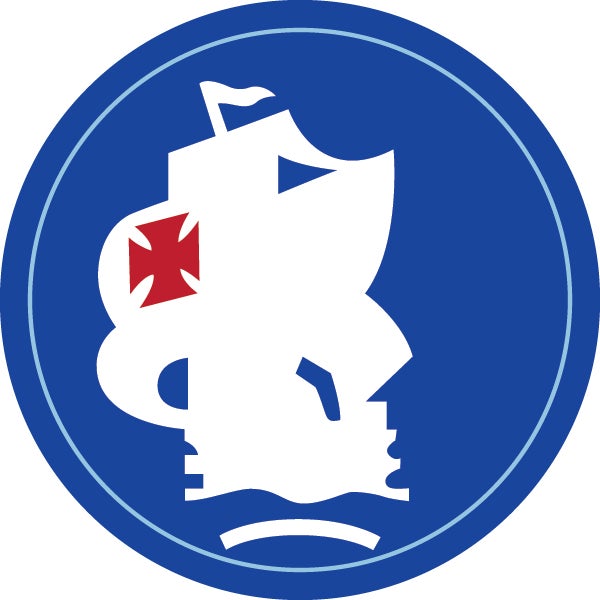
U.S. Army South
(USARSOUTH)
Fort Sam Houston, Texas
Mission: As the joint forces land component command and ASCC for U.S. Southern Command (USSOUTHCOM), USARSOUTH conducts unified land operations, sets and maintains the theater, and conducts security cooperation operations and activities in the USSOUTHCOM area of responsibility (AoR) in order to counter malign influences and threats in support of a networked defense of the U.S. homeland. On order, it provides a headquarters that is capable of a joint task force response to emergent requirements and tasked contingency plans.
The USARSOUTH commander is responsible for maintaining land-domain situational understanding and coordinating authority for forces operating throughout the theater—an AoR that encompasses 31 countries and 16 dependencies and areas of special sovereignty in Central and South America and in the Caribbean. The region represents about one-sixth of the land mass of the world assigned to regional unified commands.
USARSOUTH maintains a deployable contingency command post capable of short-notice deployments in support of USSOUTHCOM’s efforts to counter transnational criminal organizations, human and drug trafficking and terrorism. Its history in Latin America dates back to 1904, when the first U.S. Soldiers arrived in Panama to assist with the construction and defense of the Panama Canal. Today, USARSOUTH’s role is much larger in the region—enhancing hemispheric security by building strong relationships, increasing mutual capabilities and improving interoperability with local armies and security forces.
Activities: USARSOUTH conducts numerous operations, exercises and activities as part of a whole-of-government approach in conjunction with partner nations. These events include:
PANAMAX. The largest exercise conducted in the Western Hemisphere, this annual SOUTHCOM-sponsored multinational exercise series focuses on ensuring the defense of the Panama Canal. USARSOUTH leads the Multinational Forces South headquarters, along with military partners from countries throughout the AoR. Personnel from approximately 24 nations, including the United States, participate in simulated training scenarios from various U.S. and partner-nation locations.
CENTAM Guardian. This is an annual multinational exercise designed to simulate regional threats and practice a combined response aimed at providing humanitarian assistance, disaster response capabilities and promoting seamless cooperation between participating militaries. The exercise builds U.S. and partner nation capacity and fosters hemispheric cooperation and collaboration between military forces. The U.S. and partner nations improve interoperability, domain awareness and information sharing—and they counter threat capabilities. The exercise locations rotate every year, with El Salvador, Guatemala, Honduras, Costa Rica, Panama and the Dominican Republic each hosting it at various times.
Medical Readiness Training Exercises (MEDRETEs). USARSOUTH routinely deploys small teams of military medical, dental and veterinary professionals for short duration exercises at the request of partner nations. This program supports total force readiness, allowing servicemembers to deploy to under-developed areas, work side-by-side with host-nation providers and gain valuable real-world experience. MEDRETEs also help to build capacity and to strengthen relationships throughout the AoR.
Exercise Southern Vanguard. This is a USSOUTHCOM-sponsored, USARSOUTH-conducted exercise at the operational and tactical levels designed to increase interoperability between U.S. and Western Hemisphere forces. Southern Vanguard is a rotating exercise that Army South conducts with partner nations in Central and South America; the ultimate goal is to establish a multinational exercise, which will improve readiness, security and interoperability. The first iteration took place in Chile in August 2021, with participating units from the U.S. Army’s 10th Mountain Division and the Chilean Army’s 3rd Mountain Division. The second took place in Brazil in December 2021, with participating units from the U.S. Army’s 101st Airborne Division (Air Assault) and the Brazilian Army’s 5th Battalion, 12th Infantry Brigade.
Staff Talks. USARSOUTH conducts bilateral staff talks each year with the armies of Brazil, Chile, Colombia, El Salvador and Peru. The program is part of a year-long planning process that culminates with a week-long senior leader engagement event. Participating armies improve knowledge and capabilities for peacekeeping, security and humanitarian assistance and disaster relief operations. At the end of the event, the USARSOUTH commander and a senior leader from each partner army sign a bilateral engagement plan to conduct training and operational engagements together in the upcoming year. The result is enhanced relationships with each partner army, a fostering of mutual understanding through military-to-military cooperation and assisting partner armies in maintaining and developing new capabilities, supporting the mutual achievement of security cooperation goals and objectives.
Reintegration. USARSOUTH conducts reintegration of U.S. personnel—servicemembers, civilians or contractors—from foreign captivity; it was the first ASCC to have a reintegration program. Reintegration is a process that provides recovered personnel with the necessary tools to effectively resume normal professional, family and community activities, with minimal physical and emotional complications.
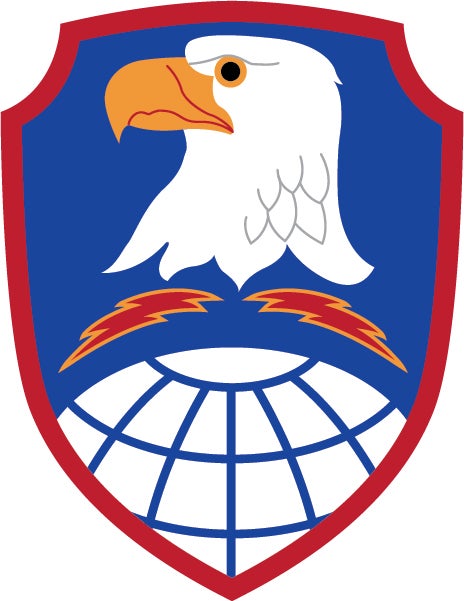
U.S. Army Space and Missile Defense Command
(USASMDC)
Redstone Arsenal, Alabama, and Peterson Air Force Base, Colorado
Mission: USASMDC develops and provides current and future global space, missile defense and high-altitude capabilities to the Army, to the joint force and to allies and partners to enable multidomain combat effects; to enhance deterrence, assurance and detection of strategic attacks; and to protect the nation.
Activities: The common link uniting USASMDC’s 3,300 Soldiers and civilians across 10 time zones and 22 dispersed locations is a commitment to defending the nation and its allies. It is the Army’s force modernization proponent and operational integrator for global space, missile defense and high-altitude capabilities. It provides trained and ready forces and capabilities to the warfighter and the nation, and it builds forces for tomorrow by researching, testing and integrating space, missile defense, cyber, directed energy, hypersonic and related technologies for the future.
Along with the command’s Technical Center and Space and Missile Defense Center of Excellence, it has three major subordinate military elements: the 100th Missile Defense Brigade (Ground-Based Midcourse Defense—GMD), the 1st Space Brigade and the U.S. Army Satellite Operations Brigade.
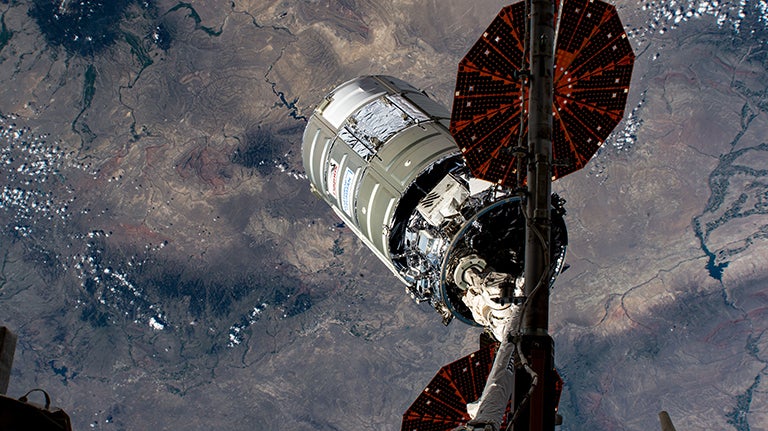 The International Space Station releases the Cygnus cargo vessel SS Katherine Johnson over southern Wyoming on 30 June 2021. As a secondary mission, the Cygnus cargo vessel deployed a U.S. Army Space and Missile Defense Command and Assured Position Navigation and Timing/Space Cross Functional Team Gunsmoke-J joint capability technology demonstration satellite (NASA photo).
The International Space Station releases the Cygnus cargo vessel SS Katherine Johnson over southern Wyoming on 30 June 2021. As a secondary mission, the Cygnus cargo vessel deployed a U.S. Army Space and Missile Defense Command and Assured Position Navigation and Timing/Space Cross Functional Team Gunsmoke-J joint capability technology demonstration satellite (NASA photo).
USASMDC supports U.S. Northern Command in its GMD mission and serves as an ASSC to both U.S. Space Command and U.S. Strategic Command (USSTRATCOM). The 100th Missile Defense Brigade operates the GMD system and functions as the missile defense component of USASMDC’s missile defense enterprise. The GMD mission is executed by Army National Guard and active component Soldiers in Colorado, Alaska and California. These Soldiers not only operate the GMD system but also provide security for the Missile Defense Complex at Fort Greely, Alaska.
Leading the command in space operations is the 1st Space Brigade. The brigade consists of the 1st Space Battalion and 2nd Space Battalion, as well as the 117th Space Battalion under a direct support relationship. The 1st Space Brigade conducts continuous space force enhancement and space control operations in support of combatant commanders, enabling and shaping decisive operations. The brigade also contains five missile defense batteries forward-stationed across U.S. Indo-Pacific Command, U.S. European Command and U.S. Central Command. The batteries operate radars in forward-based mode, conducting ballistic missile search and track and discrimination operations in support of regional and homeland defense. Additionally, forward-based mode radars enable space operations and conduct data collection.
The U.S. Army Satellite Operations Brigade, established in 2019 under USASMDC, is transferring to the U.S. Space Force during 2022. The brigade, comprising the 53rd Signal Battalion and the Satellite Command Directorate, executes continuous tactical, operational and strategic satellite communications payload management across the full spectrum of operations in support of combatant commands, services, U.S. government agencies and international partners. This transfer will be completed methodically and carefully to ensure no degradation to the important service that these Soldiers and civilians provide to the nation.
The Technical Center manages science and technology, research and development and conducts test programs for space, integrated air and missile defense, directed energy, hypersonic and related technologies. It develops and transitions space and missile defense technology to the warfighter to address current and future capability gaps in persistent communication; intelligence, surveillance and reconnaissance; force protection; and strike. It provides critical technologies that meet today’s requirements and addresses future needs, enabling warfighter effectiveness in the core competencies of directed energy, space, high altitude systems, cyberspace and missile defense.
The Space and Missile Defense Center of Excellence is the command’s architect for future force design. The team is charged to design, build, modernize, train and educate Army space and missile defense forces, and is the Army’s force modernization proponent responsible for managing Army change to doctrine, organization, training, materiel, leadership and education, personnel, facilities and policy. It develops and integrates innovative doctrine, concepts and capabilities; trains and educates agile, adaptive and ready Soldiers and leaders; executes life-cycle management for Functional Area 40 Army space operations officers; develops the Army space cadre; and enables informed decisionmaking through studies, analyses, modeling and simulation within the capabilities of Army and joint space, missile defense and high altitude.
USASMDC is also the proponent for the Army astronaut program and provides support to NASA with an Army detachment assigned to Johnson Space Center in Houston, Texas. Army astronauts help the Army to define its requirements for the space program and to enhance the Army’s use of space capabilities.
The USASMDC commanding general also has several other responsibilities: he serves as the senior commander of both Fort Greely and U.S. Army Garrison Kwajalein Atoll, Republic of the Marshall Islands, where he is responsible for the care of servicemembers, families and civilians and enabling unit readiness; he is the Army’s Air and Missile Defense Enterprise integrator; and he serves as the commander of USSTRATCOM’s joint functional component command for integrated missile defense.
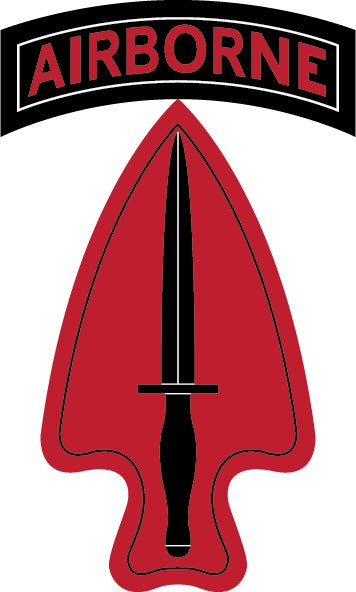
U.S. Army Special Operations Command
(USASOC)
Fort Bragg, North Carolina
Mission: USASOC generates special operations forces, validates and certifies headquarters for deployment and modernizes for the future. It serves as the center of excellence and proponent for three Army branches and is the force provider for all Army special operations forces (ARSOF) operational requirements. Its people are uniquely assessed, organized, trained and equipped, and its partnerships, cultural understanding, diversity of thought and enduring relationships enable the current presence of more than 2,800 Soldiers in 77 countries.
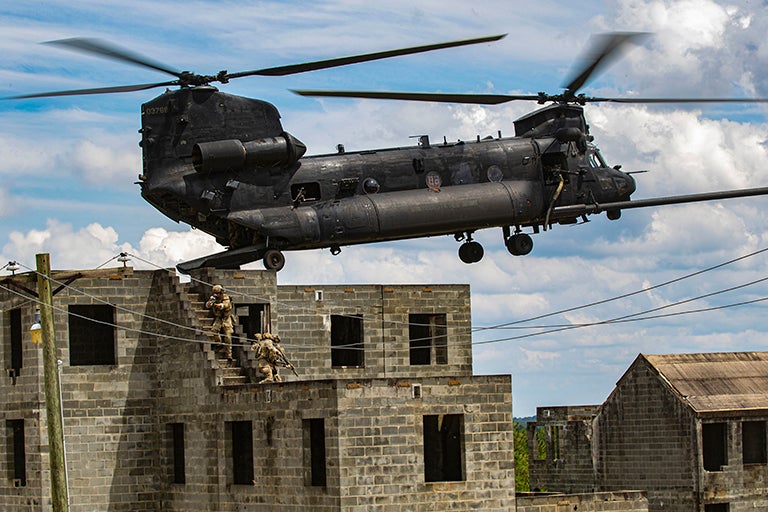 The U.S. Army Special Operations Command conducted their capabilities exercise, CAPEX 19, at Fort Bragg, North Carolina, 10–13 June 2019. This scenario, based on potential real-world Special Operations Forces mission requirements, was designed to improve interoperability with conventional forces, enhance interagency and intergovernmental partnerships and test capabilities (U.S. Army photo by Specialist ShaTyra Reed).
The U.S. Army Special Operations Command conducted their capabilities exercise, CAPEX 19, at Fort Bragg, North Carolina, 10–13 June 2019. This scenario, based on potential real-world Special Operations Forces mission requirements, was designed to improve interoperability with conventional forces, enhance interagency and intergovernmental partnerships and test capabilities (U.S. Army photo by Specialist ShaTyra Reed).
The U.S. Army John F. Kennedy Special Warfare Center and School (USAJFKSWCS) generates forces for USASOC. The school is responsible for assessing, selecting and training Soldiers in special operations competencies. USAJFKSWCS consists of two Special Warfare Training Groups and a Special Operations Medical Training Group, serving as a Center of Excellence and proponent and representing the Special Forces, civil affairs and psychological operations branches. Each year, USAJFKSWCS trains more than 13,000 Army, joint and foreign military personnel in basic and advanced ARSOF skills. The school teaches 115 courses and 12 languages at 180 training locations in 22 different states. As a standards-based organization, this is where USASOC forges expectations, culture and values.
1st Special Forces Command (1st SFC) is task-organized to conduct irregular warfare campaigning with a transregional focus on Chinese and Russian malign activity. It provides regionally aligned, culturally attuned forces consisting of 11 subordinate headquarters: five active Special Forces Groups, two National Guard Special Forces Groups, two Psychological Operations Groups, a Civil Affairs Brigade and a Sustainment Brigade. These forces develop deep regional understanding and maintain persistent focus on the National Defense Strategy priorities. 1st SFC provides a steady state campaigning headquarters with transregional Continental United States (CONUS)-based operational support to the theater special operations commands and geographic combatant commands. 1st SFC is also responsible for providing a deployable two-star special operations joint task force contingency on behalf of USSOCOM.
The U.S. Army Special Operations Aviation Command provides precision rotary wing aviation and unmanned aerial vehicles (UAVs) for ARSOF worldwide. Aviators and crewmembers are highly trained to maintain and operate the most advanced helicopters and UAV systems. 160th Special Operations Aviation Regiment is the DoD’s premier tactical denied-area penetrating force. They fly in high-risk and politically sensitive areas where others cannot go. They also provide advisory support to enhance the aviation capabilities of allies and partners.
The 75th Ranger Regiment is the nation’s premier light infantry force. They take great pride in their ability to deploy in a manner that is painfully light yet profoundly lethal. Rangers maintain a fighting force capable of rapidly deploying on short notice anywhere in the world. Their regiment remains postured for critical, over-the-horizon counterterrorism missions and joint forcible entry operations.
★ ★ ★ ★
Chapter 10: Direct Reporting Units
2022 Profile of the United States Army
Foreword
Chapter 1: National Defense
Chapter 2: The Land Component
Chapter 3: Army Organization
Chapter 4: The Soldier
Chapter 5: The Uniform
Chapter 6: The Army on Point
Chapter 7: Army Families
Chapter 8: Army Commands
Chapter 9: Army Service Component Commands
Chapter 10: Direct Reporting Units

